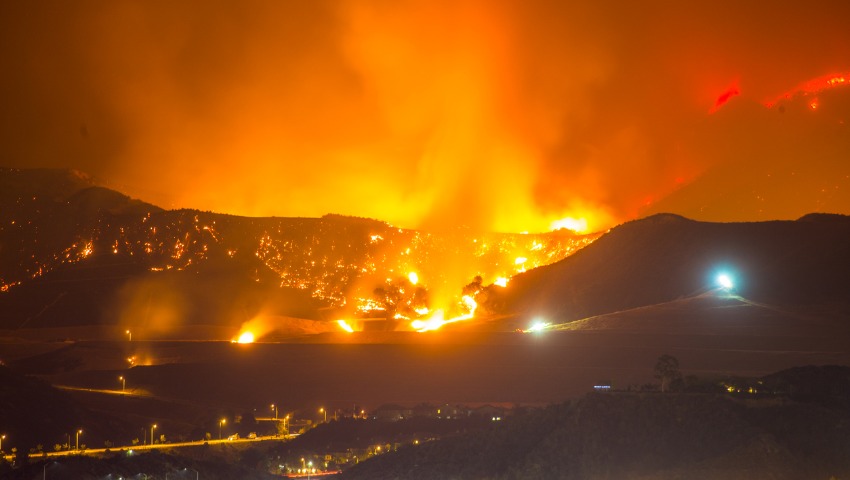Editor’s Note: One year later and our thoughts are again with our neighbors facing blackouts, evacuation and loss of property. We are without power in our offices, but still working hard to bring you the news you need to do your job wherever you are. The tips below are still helpful as our job is to keep our teams and our guests safe no matter what happens. Have you had a meeting impacted by the fires and blackouts? How did you adjust? Email us at editor@smartmeetings.com.
In what has become a far too familiar cycle, California is again dealing with a rash of wildfires, now officially declared federal disasters. Starting Thursday, November 8, a wildfire known as the Camp Fire has burned in the hills and communities of Butte County, 80 miles north of Sacramento. Meanwhile, two more fires have raged in Southern California—the Hill Fire in Ventura County and the Woolsey Fire in Ventura and Los Angeles Counties. The Camp Fire is now the largest and deadliest fire in California history, taking at least 42 lives, destroying 125,000 acres, and nearly 7,000 structures. While not as extensive, the Woolsey Fire has taken two lives, consumed nearly 100,000 acres of its own and destroyed 435 buildings.
Meetings industry leaders throughout the state have rushed to provide support for those affected by the flames and smoke while sharing updates about all the areas unharmed and still open for business. Visit California posted, “California is a large state and wildfires in one location typically have no impact outside a limited area. In fact, a vast majority of the Golden State is currently unaffected by fires. Visit California’s first concern is always the safety and well-being of California residents and visitors, so we recommend that visitors who are planning a trip to California contact their hotel and local convention and visitor’s bureau for all pertinent updates.”
Discover Los Angeles posted, “Our thoughts are with the heroic first responders, our neighbors in Malibu, Ventura County, and the Los Angeles County residents currently impacted by wildfires. As the official destination marketing organization for Los Angeles, visitor safety is our utmost priority. We work closely with local, state, and federal officials as well as with our partners to ensure that we collectively deliver on this objective.… At this time, there is no structural or logistical impact to the City of Los Angeles that would affect visitors.”
More: Natural Disasters Create New Challenges for Meetings Industry
Clear the Air
While the Santa Anna winds—60-70mph gusts in Southern California—present a dangerous variable for firefighters, it is having the added effect of cleaning the air. Throughout the state, air quality has been an ongoing issue, with portions of the state still under moderate to unhealthy air quality advisories.
Those planning events in affected areas can take proactive steps to keep themselves and attendees safe.
- Check local air quality reports and visibility guides. Listen and watch for news or health warnings about smoke, such as on AirNow.gov and AirFire.org. Some communities also maintain online monitors that measure the amount of particles in the air.
- Keep indoor air as clean as possible. Keep windows and doors of venues closed. Have the venue run an air conditioner, but keep the fresh-air intake closed and the filter clean to prevent outdoor smoke from getting inside.
- Adjust agendas to reduce exposure. This could include moving outdoor activities inside or reducing strenuous exercises that could exacerbate breathing problems.
- Prevent wildfires from starting. Prepare, build, maintain and extinguish campfires safely. Follow local regulations if you burn trash or debris.
- Do not rely on dust masks for protection. Paper “comfort” or “dust” masks commonly found at hardware stores are designed to trap large particles, such as sawdust. These masks will not protect your lungs from the small particles found in wildfire smoke. Only use masks with respirators.
- Plan ahead. Establish a chain of command, communicate assembly points, keep a list of guests, including individuals with special needs.
How to Help
While, the federal government has issued a disaster declaration, clearing the way for FEMA and federal funds to reach victims of the fires, more aid is welcome. Paul Van Deventer, president and CEO of MPI, said in a statement, “Meeting Professionals International shares a deep concern for those feeling the impact of the California wildfires, including members of our Northern and Southern California chapters. We extend our prayers for relief. If you would like to show your support with a donation, we encourage you to explore the many organizations providing immediate assistance to those in need on the ground, including the American Red Cross.”
You can donate to the Red Cross here.
Donated items often go unused and just take up space. If you do feel the desire to donate, organizers point to money and gift cards for all purpose stores such as Target and Walmart as being the most helpful. Additionally, there are programs such as Airbnb Open Homes that allow you to list your home as housing for evacuees. For more general donation opportunities, see the following.
California Community Foundation’s Wildfire Relief Fund: Supporting victims with rebuilding homes and medical treatment.
North Valley Community Foundation: Supporting the evacuation centers themselves.
Humane Society of Ventura County: Supporting animal relief in Southern California.




